2009 Hyundai Getz warning
[x] Cancel search: warningPage 163 of 191
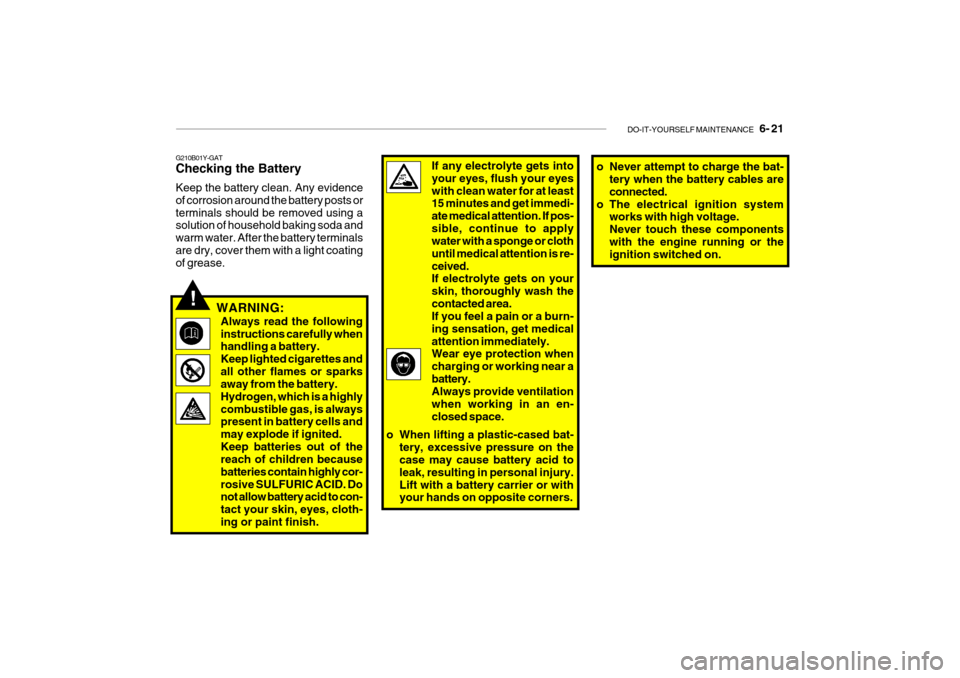
DO-IT-YOURSELF MAINTENANCE 6- 21
If any electrolyte gets into your eyes, flush your eyeswith clean water for at least 15 minutes and get immedi- ate medical attention. If pos-sible, continue to apply water with a sponge or cloth until medical attention is re-ceived. If electrolyte gets on your skin, thoroughly wash thecontacted area. If you feel a pain or a burn- ing sensation, get medicalattention immediately. Wear eye protection when charging or working near abattery. Always provide ventilation when working in an en-closed space.
o When lifting a plastic-cased bat- tery, excessive pressure on the case may cause battery acid to leak, resulting in personal injury.Lift with a battery carrier or with your hands on opposite corners.
!
G210B01Y-GAT Checking the Battery Keep the battery clean. Any evidence of corrosion around the battery posts orterminals should be removed using a solution of household baking soda and warm water. After the battery terminalsare dry, cover them with a light coating of grease.
WARNING:
Always read the following instructions carefully when handling a battery. Keep lighted cigarettes andall other flames or sparks away from the battery. Hydrogen, which is a highlycombustible gas, is always present in battery cells and may explode if ignited.Keep batteries out of the reach of children because batteries contain highly cor-rosive SULFURIC ACID. Do not allow battery acid to con- tact your skin, eyes, cloth-ing or paint finish. o Never attempt to charge the bat-
tery when the battery cables areconnected.
o The electrical ignition system works with high voltage.Never touch these componentswith the engine running or the ignition switched on.
Page 164 of 191
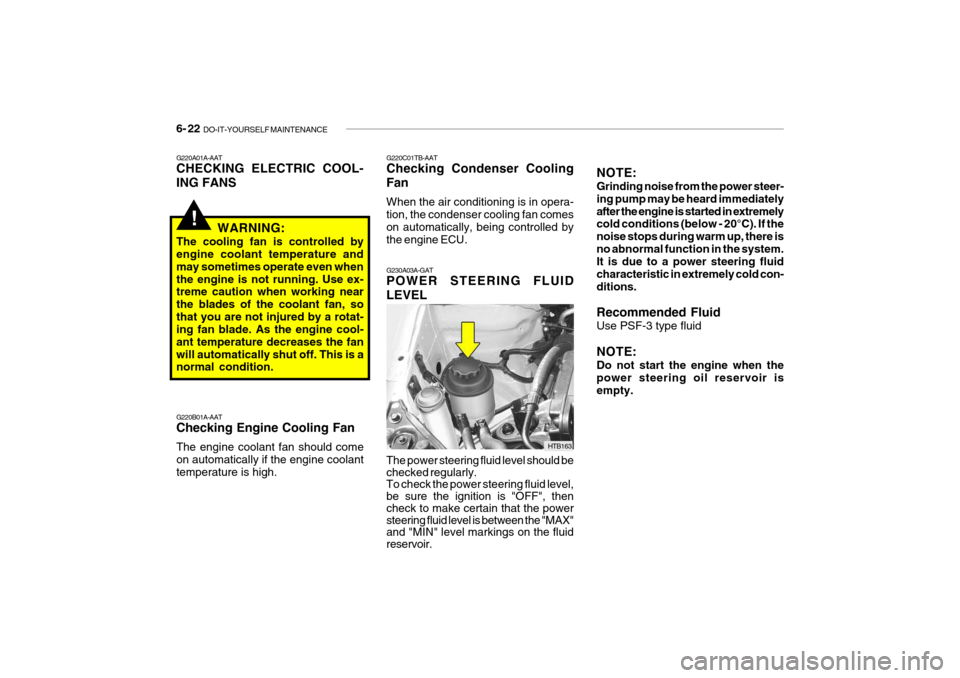
6- 22 DO-IT-YOURSELF MAINTENANCE
G230A03A-GAT POWER STEERING FLUID LEVEL The power steering fluid level should be checked regularly. To check the power steering fluid level, be sure the ignition is "OFF", then check to make certain that the power steering fluid level is between the "MAX" and "MIN" level markings on the fluid reservoir. HTB163NOTE: Grinding noise from the power steer- ing pump may be heard immediatelyafter the engine is started in extremely cold conditions (below - 20°C). If the noise stops during warm up, there isno abnormal function in the system. It is due to a power steering fluid characteristic in extremely cold con-ditions. Recommended Fluid Use PSF-3 type fluid NOTE: Do not start the engine when the power steering oil reservoir is empty.
!
G220A01A-AAT CHECKING ELECTRIC COOL- ING FANS
WARNING:
The cooling fan is controlled by engine coolant temperature and may sometimes operate even whenthe engine is not running. Use ex- treme caution when working near the blades of the coolant fan, sothat you are not injured by a rotat- ing fan blade. As the engine cool- ant temperature decreases the fanwill automatically shut off. This is a normal condition. G220B01A-AAT Checking Engine Cooling Fan The engine coolant fan should come on automatically if the engine coolanttemperature is high. G220C01TB-AAT Checking Condenser Cooling Fan When the air conditioning is in opera- tion, the condenser cooling fan comes on automatically, being controlled by
the engine ECU.
Page 168 of 191
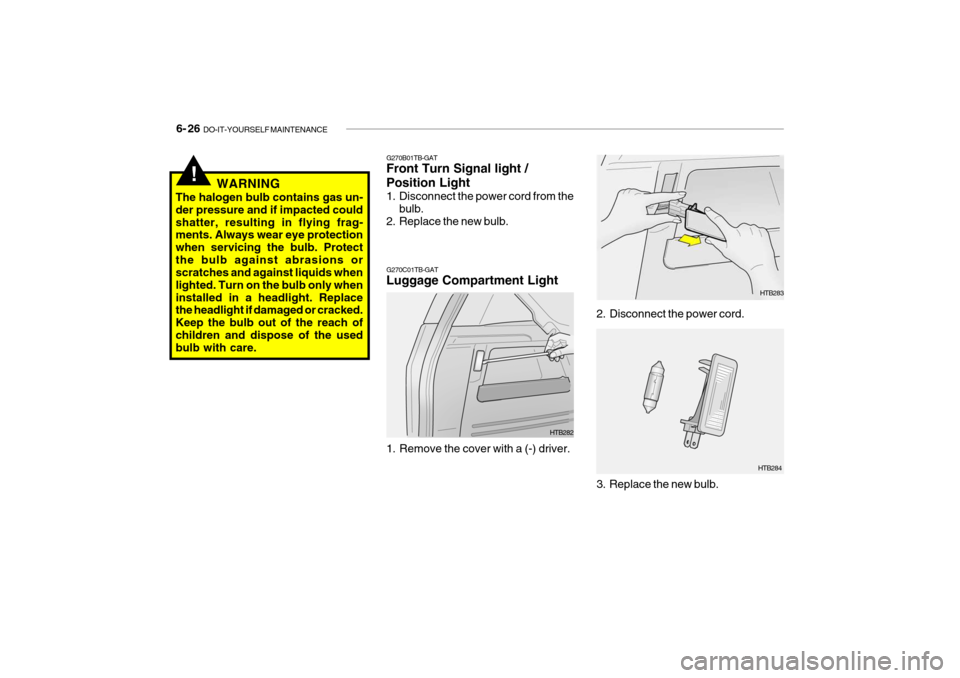
6- 26 DO-IT-YOURSELF MAINTENANCE
3. Replace the new bulb. HTB284
G270C01TB-GAT Luggage Compartment Light
HTB282
1. Remove the cover with a (-) driver. 2. Disconnect the power cord.
HTB283
!WARNING
The halogen bulb contains gas un- der pressure and if impacted couldshatter, resulting in flying frag- ments. Always wear eye protection when servicing the bulb. Protectthe bulb against abrasions or scratches and against liquids when lighted. Turn on the bulb only wheninstalled in a headlight. Replace the headlight if damaged or cracked. Keep the bulb out of the reach ofchildren and dispose of the used bulb with care. G270B01TB-GAT Front Turn Signal light / Position Light
1. Disconnect the power cord from the
bulb.
2. Replace the new bulb.
Page 173 of 191
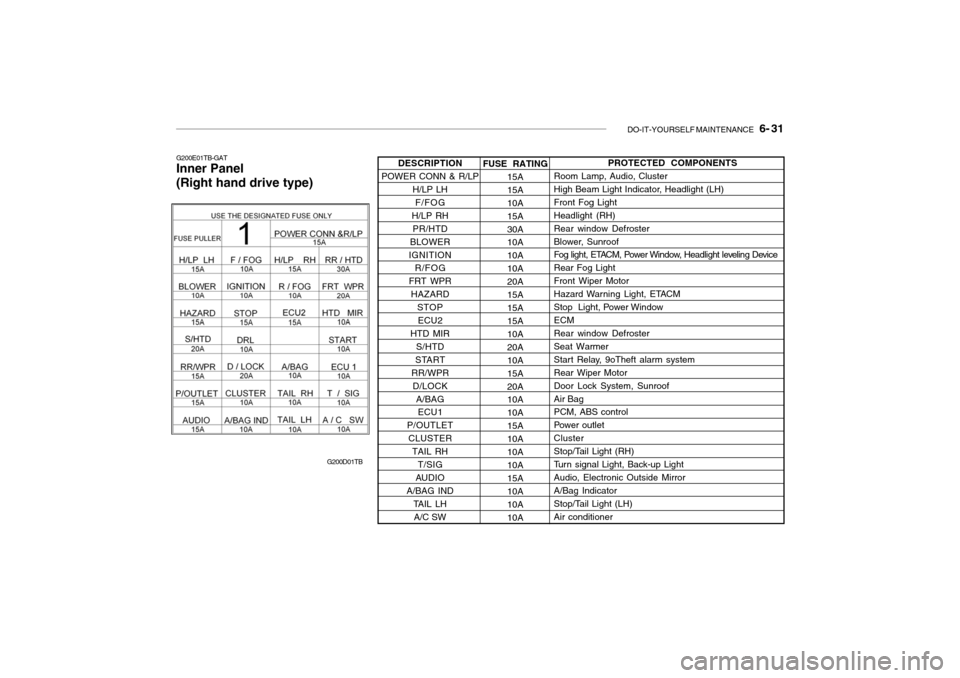
DO-IT-YOURSELF MAINTENANCE 6- 31
G200E01TB-GAT Inner Panel (Right hand drive type)
G200D01TBFUSE RATING15A 15A10A15A30A 10A 10A10A20A15A15A 15A 10A20A10A15A20A 10A 10A15A10A10A10A 15A 10A10A10A PROTECTED COMPONENTS
Room Lamp, Audio, Cluster
High Beam Light Indicator, Headlight (LH)Front Fog LightHeadlight (RH)Rear window Defroster
Blower, Sunroof
Fog light, ETACM, Power Window, Headlight leveling Device Rear Fog LightFront Wiper Motor
Hazard Warning Light, ETACM
Stop Light, Power WindowECM Rear window Defroster Seat Warmer
Start Relay, 9oTheft alarm systemRear Wiper MotorDoor Lock System, SunroofAir Bag PCM, ABS control
Power outletCluster
Stop/Tail Light (RH)
Turn signal Light, Back-up LightAudio, Electronic Outside Mirror A/Bag Indicator
Stop/Tail Light (LH)Air conditioner
DESCRIPTION
POWER CONN & R/LP H/LP LH
F/FOG
H/LP RH PR/HTD
BLOWER
IGNITION R/FOG
FRT WPR HAZARD STOPECU2
HTD MIR S/HTD
START
RR/WPR D/LOCK A/BAGECU1
P/OUTLET
CLUSTER TAIL RH T/SIG
AUDIO
A/BAG IND
TAIL LHA/C SW
Page 180 of 191
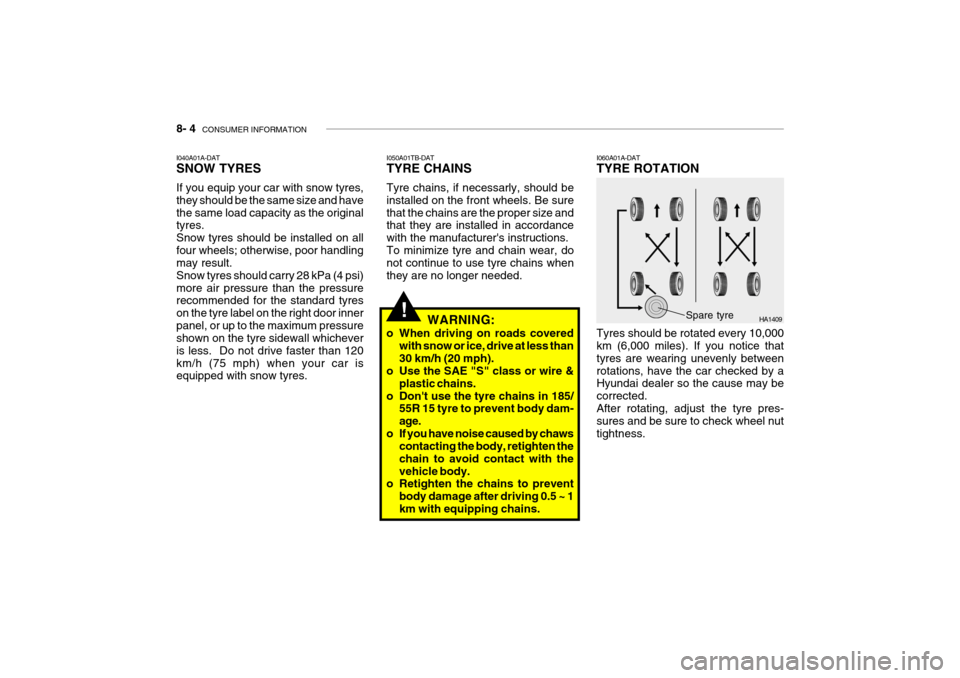
8- 4 CONSUMER INFORMATION
!
I050A01TB-DAT TYRE CHAINS Tyre chains, if necessarly, should be installed on the front wheels. Be surethat the chains are the proper size and that they are installed in accordance with the manufacturer's instructions.To minimize tyre and chain wear, do not continue to use tyre chains when they are no longer needed.
I040A01A-DAT SNOW TYRES If you equip your car with snow tyres, they should be the same size and havethe same load capacity as the original tyres. Snow tyres should be installed on allfour wheels; otherwise, poor handling may result. Snow tyres should carry 28 kPa (4 psi)more air pressure than the pressure recommended for the standard tyres on the tyre label on the right door innerpanel, or up to the maximum pressure shown on the tyre sidewall whichever is less. Do not drive faster than 120km/h (75 mph) when your car is equipped with snow tyres. I060A01A-DAT TYRE ROTATION Tyres should be rotated every 10,000 km (6,000 miles). If you notice that tyres are wearing unevenly betweenrotations, have the car checked by a Hyundai dealer so the cause may be corrected.After rotating, adjust the tyre pres- sures and be sure to check wheel nut tightness.
HA1409Spare tyre
WARNING:
o When driving on roads covered with snow or ice, drive at less than 30 km/h (20 mph).
o Use the SAE "S" class or wire &
plastic chains.
o Don't use the tyre chains in 185/ 55R 15 tyre to prevent body dam-age.
o If you have noise caused by chaws contacting the body, retighten thechain to avoid contact with thevehicle body.
o Retighten the chains to prevent
body damage after driving 0.5 ~ 1km with equipping chains.
Page 181 of 191
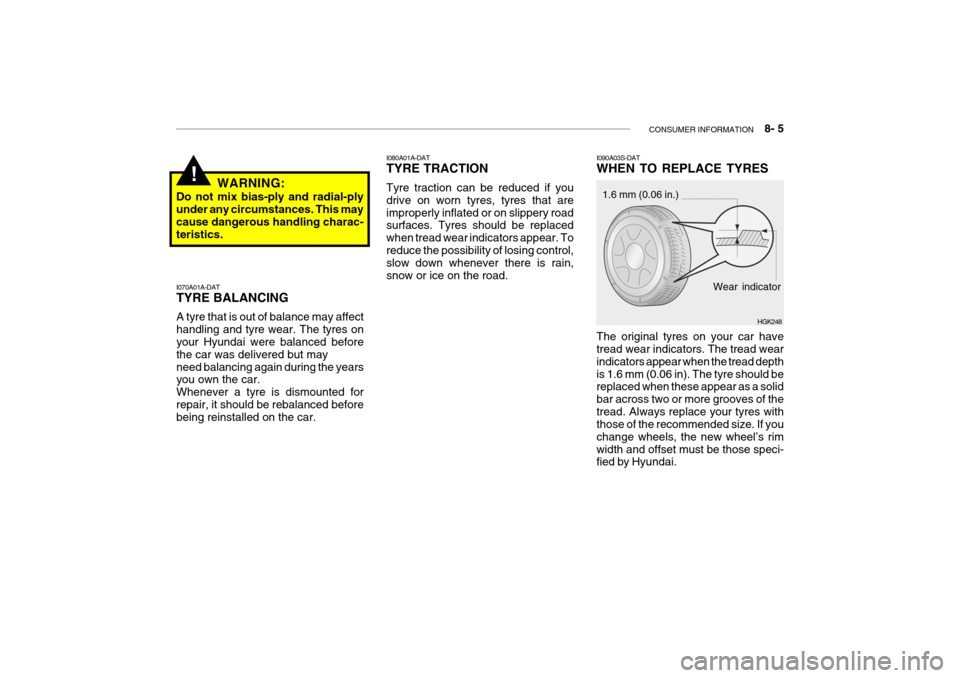
CONSUMER INFORMATION 8- 5
!
I070A01A-DAT TYRE BALANCING A tyre that is out of balance may affect handling and tyre wear. The tyres on your Hyundai were balanced before the car was delivered but mayneed balancing again during the years you own the car. Whenever a tyre is dismounted forrepair, it should be rebalanced before being reinstalled on the car. I080A01A-DAT TYRE TRACTION Tyre traction can be reduced if you drive on worn tyres, tyres that areimproperly inflated or on slippery road surfaces. Tyres should be replaced when tread wear indicators appear. Toreduce the possibility of losing control, slow down whenever there is rain, snow or ice on the road.
I090A03S-DAT WHEN TO REPLACE TYRESWear indicator
1.6 mm (0.06 in.)
HGK248
WARNING:
Do not mix bias-ply and radial-ply under any circumstances. This may cause dangerous handling charac-teristics.
The original tyres on your car have tread wear indicators. The tread wear indicators appear when the tread depthis 1.6 mm (0.06 in). The tyre should be replaced when these appear as a solid bar across two or more grooves of thetread. Always replace your tyres with those of the recommended size. If you change wheels, the new wheel’s rimwidth and offset must be those speci- fied by Hyundai.
Page 182 of 191
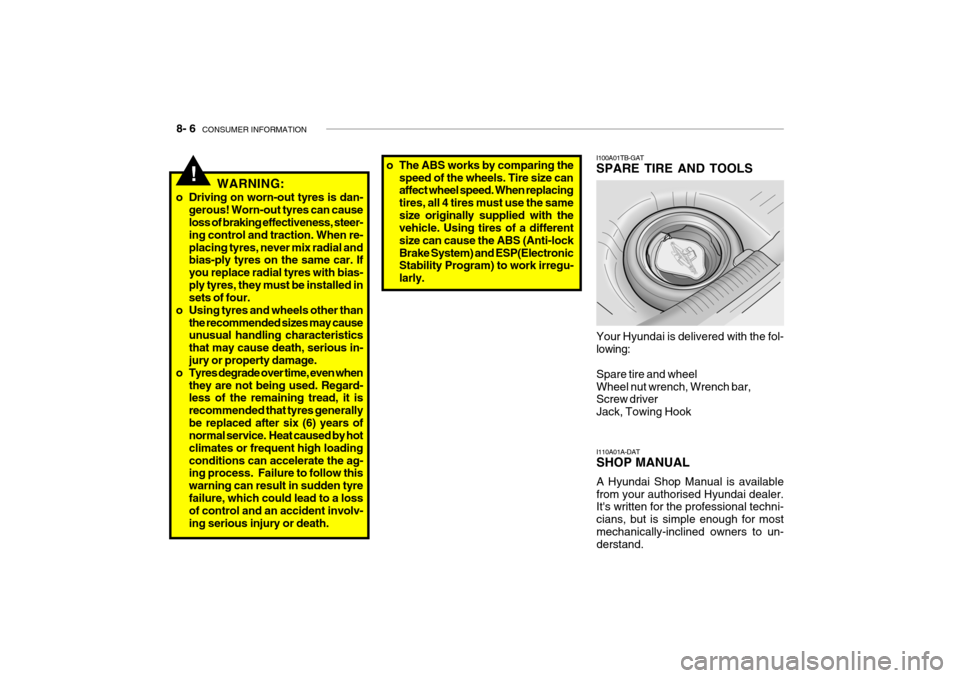
8- 6 CONSUMER INFORMATION
I100A01TB-GAT SPARE TIRE AND TOOLS
Your Hyundai is delivered with the fol- lowing: Spare tire and wheel Wheel nut wrench, Wrench bar, Screw driver Jack, Towing Hook HTB224
I110A01A-DAT SHOP MANUAL A Hyundai Shop Manual is available from your authorised Hyundai dealer. It's written for the professional techni- cians, but is simple enough for mostmechanically-inclined owners to un- derstand.
!WARNING:
o Driving on worn-out tyres is dan- gerous! Worn-out tyres can cause loss of braking effectiveness, steer- ing control and traction. When re-placing tyres, never mix radial and bias-ply tyres on the same car. If you replace radial tyres with bias-ply tyres, they must be installed in sets of four.
o Using tyres and wheels other than
the recommended sizes may causeunusual handling characteristics that may cause death, serious in- jury or property damage.
o Tyres degrade over time, even when
they are not being used. Regard-less of the remaining tread, it is recommended that tyres generallybe replaced after six (6) years of normal service. Heat caused by hot climates or frequent high loadingconditions can accelerate the ag- ing process. Failure to follow this warning can result in sudden tyrefailure, which could lead to a loss of control and an accident involv- ing serious injury or death. o The ABS works by comparing the
speed of the wheels. Tire size can affect wheel speed. When replacing tires, all 4 tires must use the samesize originally supplied with the vehicle. Using tires of a different size can cause the ABS (Anti-lockBrake System) and ESP(Electronic Stability Program) to work irregu- larly.
Page 189 of 191

INDEX 10- 3
Drink Holder ................................................................ 1-54
Drive Belts .................................................................. 6-18
Driving Economical driving .................................................. 2-14
Smooth corneri ng ..................................................... 2-15
Winter driving ........................................................... 2-15
E Emission Contro l System ............................................ 7-2
Engine Before starting the engine ........................................ 2-3Compartment ............................................................ 6-2
Coolant ..................................................................... 6-6
Coolant temperature Indicator ..................................1-41
If the engine overheats ............................................. 3-4
Number ..................................................................... 8-2
Oil ............................................................................. 6-4Starting ..................................................................... 2-4
Engine Exhaust Can Be Dangerous ............................ 2-2
F
Fan Speed Control ...................................................... 1-72
Fog Light
Front ........................................................................ 1-51
Front Seats Adjustable front seats .............................................. 1-12Adjustable headrests
............................................... 1-13
Adjusting seat forward and rearward ........................1-12
Adjusting seatback angle .. ......................................1-12
Lumbar support control ............................................ 1-14
Seat cushion height adjustment .............................. 1-14
Fuel
Capacity ................................................................... 9-2
Gauge ...................................................................... 1-41
recommendations ...................................................... 1-2
Fuel Filler Lid Remote release ....................................................... 1-63
Fuses ......................................................................... 6-18
Fuse panel Description ............................................... 6-30
GGeneral Checks ........................................................... 6-4
Glove Box .................................................................. 1-58
H Hand Brake ................................................................. 1-61
Hazard Warning System ............................................. 1-50
Headlight Aiming Adjustment...................................... 6-23
Heating and Cooling Control .......................................1-71
Air flow control ......................................................... 1-73
Air intake control ..................................................... 1-73
Bi-level heati ng ........................................................ 1-76
Fan speed control .................................................... 1-72
Temperature control ................................................. 1-75